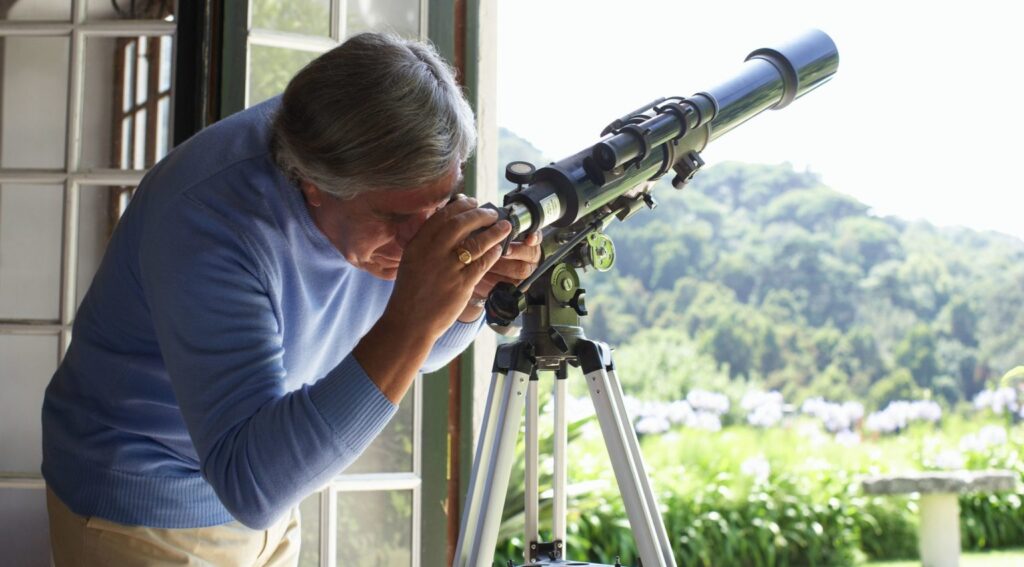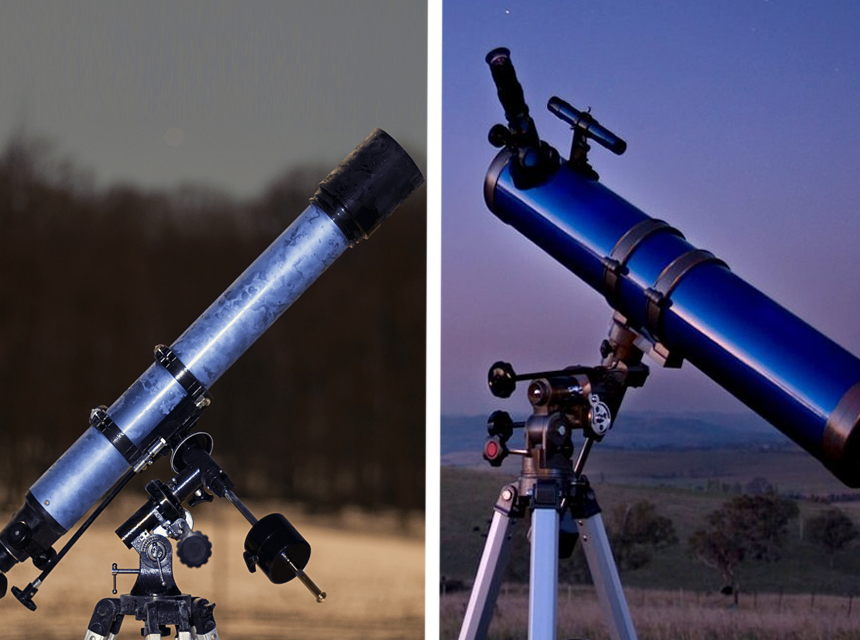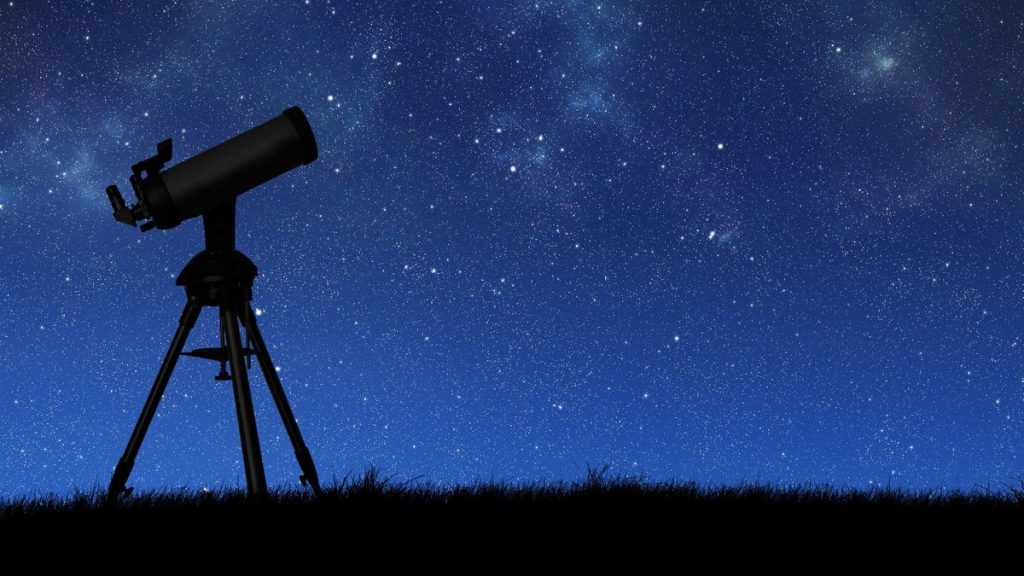Gazing into space may imply blankness and boredom, but if you do it behind a telescope, it turns into a captivating celestial adventure of the mystery and beauty of our universe. Telescopes enable us to explore massive galaxies with the magnificent Milky Way, spellbinding stars, and cute comets.
Our comprehensive review will introduce you to the 5 best telescopes under $500 that we’ve selected from more than 20 models. We have analyzed the features that make the best telescope to get you started on your astronomy journey. First of all, there are three types of telescopes (to wit, reflector, refractor, and computerized), so we have both types in our list. Second, there are multiple optical characteristics such as aperture and focal length, that are crucial. During our research and testing the Gskyer Telescope AZ70400 really stood out, so we decided to make it our Editor’s Choice.
More features: antireflection blue film optical coating, fully-coated, 1-year warranty and lifetime maintenance, one 3x Barlow lens, beginner friendly, phone attachment, Bluetooth remote, carry bag, aluminum alloy tripod
Gskyer is a fairy popular brand that deals in making telescopes. The Telescope AZ70400 model is one of the best options on the market and it is the number one option on this roundup.
If you are looking for a model that is affordable and compact, ready to go with you on your trips to the country, then you should consider this model. It comes with plenty of interesting features that makes it better than many of telescopes in a similar price range. For example, it comes with a large aperture that allows light through the lens to give you very bright images withg ood contrast.
It comes with instructions that are simple to understand and that ensure that you can set up the Gskyer Telescope AZ70400 in a short time.
Due to the optical coating, the lens ensures your safety as you look through it.
Among other accessories, there are replaceable eyepieces that elevate your viewing experience. There is also a Barlow lens to increase the magnification power of the telescope.
Overall, it is a durable and compact model that will not tear a hole in your pocket.
Although it is an excellent entry-level model, it falls short when used for Deep Sky viewing. It is not for expert astronomers as it lacks the necessary power to qualify as such.
More features: Sky Tour feature automatically generates a list of objects currently visible
NexStar 127SLT is the best computerized telescope under $500 for beginners and intermediate astronomers. Featuring the durable Maksutov-Cassegrain design, SkyAlign technology, advanced optics, and powerful light gathering ability, this catadioptric telescope is, without doubt, the best telescope for astrophotography under $500.
The long focal length of 1500 mm, 127-mm aperture and the slow speed of optics at a focal ratio of f/12 provide high magnification of planetary and lunar objects for clear and detailed viewing and photography. It also includes 25 mm and 9 mm eyepieces with 60X and 167X magnification accordingly.
SkyAlign technology, the GOTO controller and the StarPointer finderscope simplify the search for celestial objects and automatically align this computerized telescope program for an accurate view, making it the best GOTO telescope under $500.
The equatorial mount is attached to an adjustable stainless steel tripod with an accessory tray and a fork arm mount. The telescope also has a helpful manual for easy installation and calibration. Also included in the package are the SkyX planetarium software and a huge database with a tracking system for 4000 celestial objects. A list of currently visible objects is automatically displayed through the Sky Tour feature.
Although the telescope is relatively light at only 18 pounds, the mount and tripod can be quite bulky to move around. As for the drawbacks, the mount has a lot of vibration, but you can offset this by adding counterweights.
More features: features a rocker-mount with Teflon bearings and tension clutch
This is the best Dobsonian telescope under $500 which allows you to observe dim and large planetary objects that do not require high magnification. It features a large aperture, typical in Dobsonian-designed Newtonian models, with a diameter of 203 mm which is powerful in gathering huge amounts of light to make dim, distant galaxies and nebulae visible.
Two Plossl eyepieces magnify these objects with focal length of 25 mm and 10mm. Exploring the deep extraterrestrial terrains through the straight-through 9×50 finderscope, along with the focal ratio of f/5.9, will reward you with an excellent field of view and brighter images.
The package includes a wooden rocker box altazimuth mount which is easy to assemble and operate. The mount has tension clutch for altitude and weather-resistant Teflon bearings for flawless mobility. However, while the long focal length of 1200 mm is great for viewing, it makes the overall unit bulky and inconvenient to disassemble and store away.
SkyWatcher S11610 has been voted as the best telescope under $500 by Reddit users. It also has excellent reviews from verified buyers for its deep sky exploration capability.
More features: features a mount with dual setting circles and slow-motion hand controls
This reflector telescope has an excellent price-performance ratio which makes it an excellent choice for beginners who are interested in stargazing and exploration of planets and galaxies.
It features a focal length of 650 mm with f/5.0 focal ratio that allows a wide field of view to see multiple objects. The two Sirius Plossl eyepieces of 10 mm and 25 mm enlarge them while the 130-mm aperture gathers plenty of light so you can see these objects clearly.
Weighing 27 pounds when fully assembled is one of the most portable units on the list. Just place it on the included EQ-2 equatorial mount with an adjustable tripod for easy tracking and slow-motion hand controls for finer adjustment, and scope out the celestial bodies with the 6×30 finder. The built-in dual setting circles will help you discover more objects when you dial their coordinates.
The package also includes Starry Night astronomy software, an accessory tray, a rack and pinion focuser, a manual, and a collimation cap which aligns the mirror for a more accurate focus.
This telescope does not have advanced features, but it offers decent value for the money and is undoubtedly the best reflector telescope under $500. However, users have reported the complications they face in assembling it due to poor and vague instructions in the manual. The online instructional videos are more helpful. Other customers received packages with missing and broken parts.
More features: stainless steel tripod featuring 1.75″ legs, accessory tray, and bubble level
If you are looking for the best beginner telescope under $500, with decent performance, durability, and portability in one unit, you should opt for this refractor model. It is equipped with two 25 mm and 20 mm eyepieces for high magnification.
The optical tube, mount, and tripod are all made of high-quality material. The aluminum tube features 1000 mm of focal length with f/9.8 focal ratio that makes it easy to locate nebula and open clusters. This focal ratio produces a right balance of magnification and light gathering ability.
The CG-4 German equatorial mount is one of the most durable and versatile mounts on the market. The adjustable stainless steel tripod has 1.75-inch thick legs, an accessory tray, and a bubble level for improved accuracy, ball bearings for smooth movement, and a central brace for additional rigidity. The mount is flexible enough to work with different telescope models.
The StarBright XLT coating, along with the aperture which has a diameter of 102 mm, optimizes transmission of light and improves contrast and color rendition.
Since Omni XLT is a refractor, there is no secondary mirror that could affect image resolution. Location and tracking of objects are made easy with the setting circles, focuser and slow motion controls.
Owners of this model loved its performance for the price, and found it one of the easiest to install. The main complaint was the finderscope which lacks a diagonal and makes viewing overhead objects uncomfortable. The heavy weight was also a minor inconvenience, but not a deal breaker.
The ultimate objective of this guide is to help you secure the best quality telescope which will cost you the least amount of money. That is why we have delved into details on the key features you should focus on when shopping. We also explain the value you can get out of these affordable models, and answer the most commonly asked questions.
A telescope in this price range will enable you to view planetary details like shadows and texture of the moon, nebulae and galaxies, among other objects. The number of details will mainly vary according to the diameter size of the aperture and the power of magnification. You can further enhance magnification with a Barrow lens. Generally, the telescope will feature an optical tube, eyepieces, lenses, a focuser, finderscope, a mount, and a tripod. A tripod and counterweights are usually included with equatorial mounts, but altazimuth mounts do not require them at all times.

These are the main features we assessed when comparing different models to come up with our best telescope under $500 list. Taking them into consideration will ease the burden of choice.
There are three major types of telescopes: reflectors, refractors, and compound, also known as catadioptric.
Reflectors gather and focus light using mirrors instead of lenses, which makes them prone to misalignment and interference by natural elements due to the open tube design, but prevents the chromatic aberration common with lenses. The secondary mirror can obstruct light and cause diffraction spikes. Reflectors, such as SkyWatcher S11610, are the best for deep sky exploration because they feature large apertures which produce bright images and a fast focal ratio which offers wide views of galaxies and nebulae.
Refractors gather and focus light using lenses that are fixed so there is no need for alignment or collimation. However, lenses can cause color fringes and distortions. The eyepiece is positioned at the lower end of the tube. Refractors generate clear and sharp images because there is no obstruction of light to the eyepiece by a secondary mirror, and the closed tube design prevents natural elements from affecting the lens. The high quality of images makes refractors ideal for observing the moon and planets, as well as for astrophotography.
Catadioptric telescopes are a hybrid of reflecting (catoptrics) and refracting (dioptrics) telescopes. They combine lenses and mirrors to gather and focus light, and most of them come with computerized functionality. This versatility makes them suitable for both astrophotography and deep sky exploration. Their compactness improves portability and storage. Telescopes of this type are usually somewhat expensive and are not included in our list.
Aperture refers to the diameter of a telescope’s main lens or mirror. The quality of a telescope is defined by its aperture’s light gathering ability, focal length, and its eyepiece’s magnification power. Since observation of celestial objects is complicated by their dimness, a telescope’s ability to brighten them matters much more than its ability to magnify.
Aperture is the most important feature you should prioritize because, unlike eyepieces which can be replaced or added for more power, an aperture does not give you the same option to adjust your choice, so make sure you get it right. Another reason to take apertures more seriously is because they determine the maximum limit of your telescope’s magnification. The larger the aperture, the higher magnification it can accommodate.
An aperture also dictates the amount of details you can view and the level of image brightness and resolution. This is particularly handy when viewing faint and distant objects, such as galaxies and nebulae. The large 203 mm aperture with powerful light gathering ability is what makes the SkyWatcher S11610 so effective in exploring the deep sky and extraterrestrial terrains.
Focal length refers to the distance from the main optical component where light is gathered to the point where it is brought to a focus for the eyepiece to form an image. This obviously influences the level of magnification. A long focal length has higher magnification but offers narrower fields of view than a short one. It is suitable for objects that are closer like the moon, stars and planets. To observe distant galaxies, choose a telescope with a short focal length and large diameter that provide wider and brighter views.
Focal length is closely associated with focal ratio which is denoted by f/number. Focal ratio is the focal length divided by the aperture diameter. A ratio of f/11 to f/15 has high magnification and narrow fields of view while a ratio of f/4 or f/5 has lower magnification, brighter images and wider fields of view suitable for dim and distant objects.
Please note that the focal length is different from the actual length of the telescope. Some models feature designs that can fit a long focal length in a short tube.
A sturdy and stable mount provides support for your telescope, allows smooth mobility, and dampens vibrations to keep it steady for objects to stay in view. It also helps locate and track celestial objects. Choosing the best mount will be based on its portability, payload, and your astronomy intention, whether scoping or focusing. Investing in a good mount will give you years of use even after you have upgraded your telescope.
Altazimuth and equatorial are the two most common types of mounts.
Altazimuth mount has a simple design that is portable and easy to set up, with no need for counterweights. It features two axes with vertical and horizontal movements which can easily locate objects. However, the linear movements are inconvenient for tracking objects as they drift along the sky in an angular arc. After zeroing in on an object, finer adjustments are made using slow motion controls.
Equatorial features two axes, with one aligning to the sky for smooth tracking of objects, an important requirement in astrophotography. The setting circles allow you to locate known objects using coordinates. The mount is usually attached to a stainless steel tripod that may have diagonal bracing to fortify it and an accessory tray. Others are motorized with automated tracking and databases of thousands of viewable objects that you can locate by keying in their coordinates. Equatorial may also have a bubble level and counterweights for balance. The heavy material and multiple items provide stable support with a large payload, but add to the overall weight which makes them inconvenient to transport. The polar alignment during installation can also be confusing for beginners.
An eyepiece uses the light gathered and focused to magnify objects and generate images. Most models include one, or two eyepieces with one optimized for wider field views and the other for higher magnification. The focal length of both the telescope and the eyepiece influences the level of magnification. To calculate eyepiece magnification, divide the telescope focal length by the eyepiece focal length.
Eyepieces with shorter focal length have higher magnification. That means a 10 mm is more powerful than a 25 mm. A Barlow lens is inserted into the focuser to double or triple the eyepiece magnification power.
Always start with the low power eyepiece when scoping because low magnifications provides wide surface area of objects to view, then use the high power eyepiece for focusing once you narrow down on an object. It is worth noting that high magnification does not always produce better images. In distant objects, it actually makes them blurry because the light is spread out thin.
Since stargazing and celestial adventures take place outdoors, you will need a telescope that you can easily move outside and store away afterwards. Most of the telescopes are light and compact. It is the mounts, steel tripods, counter weights and additional accessories that make the entire set bulky.
Knowing the size and dimensions of the telescope will help you determine its portability and compare it with payload when shopping for a mount. Additional accessories include software, such as the Starry Night in Orion 09007 and the SkyX in Celestron NexStar 127SLT; database of celestial objects; instructional DVDs and manuals; and an accessory tray. Since telescopes are long-term investments, a long warranty is also an essential feature to consider.
Gskyer Telescope AZ70400 targets beginners in the astronomy and it has the great features to impress them. Thanks to its affordability, beginners can benefit from its high quality performance and take their astrophotography skills to the next level. Too good to be true? We initially thought so, but an overwhelming majority of buyers have proved it to be an outstanding unit. It was our favorite telescope because it combines superior optics with affordability.
NexStar 127SLT won our hearts for the same reason: high quality yet affordable. It is equipped with innovative technology, automated features, planetary software, and an extensive database of viewable objects that can be easily located and tracked.
SkyWatcher S11610 edged out other models to rank among the top of our best telescopes under $500 list with the Dobsonian design which has a cult following, and with good reason. A look at the features of this model, which include a large 203mm aperture and the altazimunth mount, makes you understand why people cannot get enough of it.
If you are on a tighter budget, we suggest you read our reviews and choose a telescope that costs less than 300 and 200 dollars.





